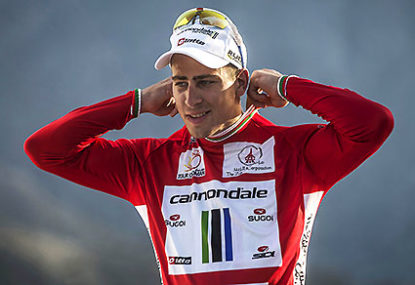'I've just won a stage of the Tour de France, mate!': Hindley grabs yellow jersey as Aussie blows Tour apart
Australia's Jai Hindley has said he is "lost for words" after a shock stage victory at the Tour de France earned him the leader's…

Having established some of the major obstacles in the way of Oleg Tinkov revolutionising cycling last week, this week I take a look at the possibilities should those hurdles not exist.
For this discussion I would like to propose there are no limits to the scale or scope of how we could change the WorldTour – as if we had a clean slate, and were starting again from scratch.
Let’s even pretend we have influence like Kerry Packer, who changed the face of cricket in the 1970s with the birth of World Series Cricket. Let’s design a new competition with similar disruptive panache.
People have tried before – World Series Cycling attempted to rout the WorldTour, but hasn’t managed to get off the ground. Aside from teams wanting a bigger slice of the TV revenue pie – which the ASO is jealously guarding – it focuses on a more coherent race calendar, with a clear points system.
A commendable concept, but it does little to improve the sport from a spectator’s perspective. The model has merit – 10 stage races over four days each, with the best riders forced to compete for overall honours at the end of the season. It’s a step in the right direction for sure, but we could be a little more creative.
I tend to fall asleep a lot watching cycling in the middle of the night, but I would still be at risk of falling asleep even if the cycling was in my timezone. 200 kilometre or five hours of racing is just too long in one hit. Frequently, riders wait until the final kilometre to attack anyway, as they risk far too much going sooner, knowing the distance to the finish may be too far to hang on.
T20 cricket is wildly popular because it’s all over in three hours. A similar concentration of cycling could be the key.
In addition to the evolution and inclusion of data discussed last week, my version would look like this:
Overview
To cater for different athletes and the different types of training required, there would need to be two major disciplines – let’s call them ‘Sprint’ and ‘Enduro’, meaning long course and short course, or Aerobic/Anaerobic, or fast twitch/slow twitch.
Weekly Sprint events in the form of a round robin – just like the biggest team sports on the planet. One team is pitched against another, fielding their best riders for any given event. The teams could all have home and away races, just like other sports.
Monthly Enduro events would see all teams on the roster convene to race in a more traditional fashion.
There could be winners or World Champions for each discipline, and perhaps an overall winner for the freaks who can do it all (Peter Sagan?).
Events
Sprint
All events run over a weekend.
Head-to-head sprints: one on one. Set up with two ramps, like those used for the start line in time trials. Winner progresses to the next round, so the field is halved each time until there is a champion.
Hill climbs: short, explosive efforts up impossibly steep hills. Four riders at at time, with the winners progressing as above.
10km team sprints: super fast. Basically a 10 kilometre lead-out to the finish line, but with only two teams in contention at a time. Winning team has the first man over the line.
Go to whoah: 300 metre individual time trial with a standstill start to top speed, coming to a complete stop with the front wheel on the finish line. Shortest time wins.
Top speed Team: teams given five minutes from the gun to register their fastest GPS top speed.
One hour city circuit criterium: could be reserved as a monthly event when teams meet for the road races, or perhaps raced weekly, making numbers up by introducing local pro teams.
Enduro
Stage races four to seven days long.
Team time trial: distance should vary month to month throughout the season.
Individual time trial: to include terrain that is flat, rolling and a mountain pass, on alternating months.
Road races over varied terrain and distance, with an emphasis on shorter stages, around 100km.
Additional points awarded for fastest times up certain climbs, irrespective of position in the race, identified using the Strava heat map.
Classics: taking in some of the traditional longer road races.
That’s how I see the sport becoming more interesting for the masses, and allowing newcomers to better understand the racing. This structure makes it easier to learn about the strengths and weaknesses of riders, and would encourage more personality to shine through, creating new stars and fans in the process.
The problem is that we don’t live in a vacuum, and all of the challenges previously raised remain.
But what if such a vacuum existed? What if there was some way to test this model without the UCI intervening, or Oleg’s personality getting in the way, and without behemoth traditional races that can’t be moved or ignored?
Sponsorship risk would still have to be considered – I would suggest testing the model in a completely separate competition. Perhaps in a competition that is fairly mature, within a strong cycling nation that is already struggling to survive and has nothing to lose.
Now where would we find one of those? Gerry Ryan?